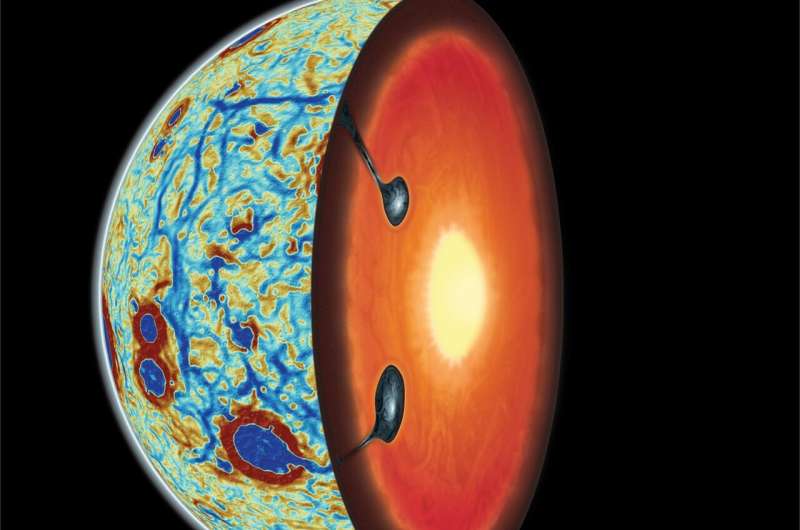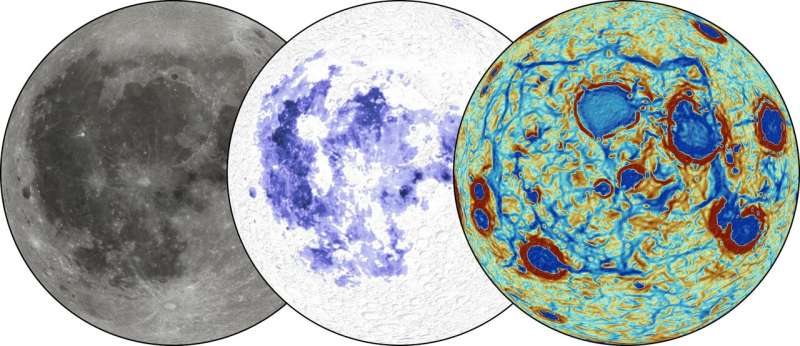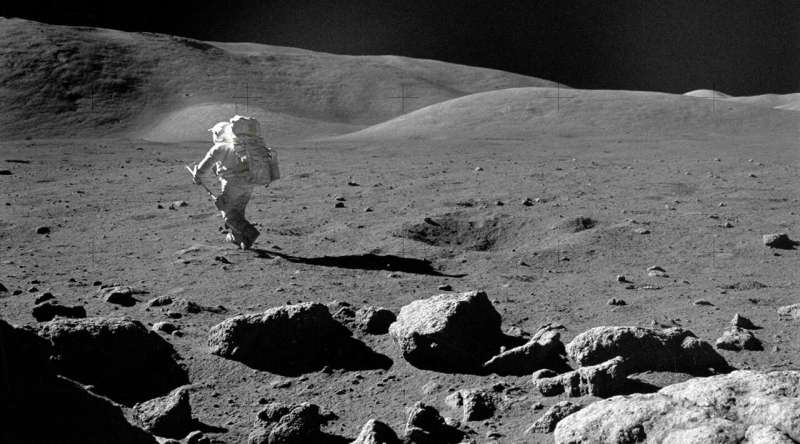
Schematic illustration with a gravity gradient map (blue hexagon pattern) of the near side of the moon and a cross section showing two ilmenite-bearing cumulate downflows from a lunar mantle rollover. Credit: Adrienne Brocke/University of Arizona and Audrey Lasbordes
About 4.5 billion years ago, a small planet crashed into the young Earth, spewing molten rock into space. Slowly, the debris fused, cooled and solidified, forming our moon. This scenario of how the moon came to be on Earth is the one that is largely agreed upon by most scientists. But the details of exactly how this happened are “more of a choice-your-own-adventure novel,” according to researchers at the University of Arizona’s Lunar and Planetary Laboratory, who published a paper in Nature Geoscience.
The findings offer important insight into the evolution of the lunar interior and potentially planets like Earth or Mars.
Most of what is known about the Moon’s origin comes from analyzes of rock samples collected by Apollo astronauts more than 50 years ago, combined with theoretical models. Samples of basaltic lava rocks returned from the Moon show surprisingly high concentrations of titanium. Later satellite observations determined that these titanium-rich volcanic rocks were located mostly near the moon, but how and why they got there remained a mystery—until now.
Because the moon formed quickly and hot, it was likely covered by a global magma ocean. As the molten rock gradually cooled and solidified, it formed the moon’s mantle and the bright crust we see when we look up at a full moon at night. But deeper below the surface, the young moon was out of balance. The models suggest that the last remnants of the magma ocean crystallized into dense minerals, including ilmenite, a mineral containing titanium and iron.
“Because these heavy minerals are denser than the mantle below, this creates a gravitational instability, and you would expect this layer to sink deeper into the lunar interior,” said Weigang Liang, who led the study as part of his doctoral work at LPL.
Somehow, over the following millennia, this dense material did sink into the interior, mix with the mantle, melt, and return to the surface as the titanium-rich lava flows we see on the surface today.
“Our moon has literally turned inside out,” said co-author and LPL Associate Professor Jeff Andrews-Hannah. “But there is little physical evidence to shed light on the exact sequence of events during this critical phase of lunar history, and there is much disagreement on the details of what happened—literally.”
Did this material sink in as it formed bit by bit, or suddenly after the moon solidified completely? Did it sink inland globally and then rise from the near side, or did it migrate to the near side and then sink? Did it sink into one big spot or several smaller ones?

The near side of the moon, with its dark regions or “mare” covered by titanium-rich volcanic flows (center), represents the familiar view of the moon from Earth (left). The mare region is surrounded by a polygonal pattern of linear gravity anomalies (blue in the image on the right), interpreted as remnants of dense material sunk into the interior. Their presence provides the first physical evidence of the nature of the global mantle reversal more than 4 billion years ago. Credit: Adrienne Brocke/University of Arizona
“Without evidence, you can choose your favorite model. Each pattern has profound implications for the geological evolution of our moon,” said one of the lead authors, Adrien Brocket of the German Aerospace Center in Berlin, who did the work during his postdoctoral research fellow at LPL.
In a previous study led by Nan Zhang of Peking University in Beijing, who also co-authored the latest paper, models predicted that a dense layer of titanium-rich material beneath the crust first migrated to the near side of the moon, possibly triggered by a giant impact in the far side, and then plunged inland in a network of sheet-like plates cascading into the lunar interior almost like waterfalls. But when this material sank, it left a small remnant in a geometric pattern of intersecting linear bodies of dense titanium-rich material beneath the crust.
“When we saw these model predictions, it was like a light bulb went off,” said Andrews-Hannah, “because we see exactly the same pattern when we look at subtle variations in the moon’s gravitational field, revealing a web of dense material that hides beneath the crust.”
In the new study, the authors compared simulations of a sinking ilmenite-rich layer to a set of linear gravity anomalies detected by NASA’s GRAIL mission, whose two spacecraft orbited the moon between 2011 and 2012, measuring small variations in its gravitational pull. These linear anomalies surround a vast dark region on the moon’s near side covered by volcanic flows known as mare (Latin for “sea”).
The authors found that the gravity signatures measured by the GRAIL mission were consistent with simulations of the ilmenite layer, and that the gravity field could be used to map the distribution of the ilmenite remnants left after most of the dense layer sank.
“Our analyzes show that the patterns and the data tell a remarkably consistent story,” Liang said. “Ilmenite materials migrated to the near side and sank inland in sheet-like cascades, leaving behind a wake that causes anomalies in the moon’s gravity field as seen by GRAIL.”
The team’s observations also constrain the timing of this event: the linear gravity anomalies are interrupted by the largest and oldest near-side shock basins and therefore must have formed earlier. Based on these cross-sector relationships, the authors suggest that the ilmenite-rich layer sank 4.22 billion years ago, consistent with it contributing to later volcanism seen on the lunar surface.
“Analyzing these variations in the moon’s gravity field has allowed us to peer beneath the moon’s surface and see what lies beneath,” said Brocke, who worked with Liang to show that anomalies in the moon’s gravity field coincide with which would be expected for the zones of dense titanium-rich material predicted by computer simulation models of lunar overturning.

More than 50 years ago, Apollo astronauts brought basaltic lava rocks from the moon with surprisingly high concentrations of titanium. Satellite observations later determined that these titanium-rich volcanic rocks were mostly found near the moon — but how and why they got there remained a mystery — until now. Credit: NASA
Crooked moon
While the detection of lunar gravity anomalies provides evidence of the sinking of a dense layer in the moon’s interior and allows a more accurate estimate of how and when this event occurred, what we see on the surface of the moon adds even more intrigue to the story , according to the research team.
“The Moon is fundamentally warped in every way,” Andrews-Hannah said, explaining that the near Earth-facing side, and a particularly dark region known as the Oceanus Procellarum region, is at a lower altitude, has a thinner crust , is largely covered in liquid lava and has high concentrations of typically rare elements such as titanium and thorium.
The remote country differs in each of these respects. In some ways, the reversal of the lunar mantle is thought to be related to the unique structure and history of the nearby Procellarum lateral region. But the details of this reversal have been a matter of considerable debate among scholars.
“Our work connects the dots between geophysical evidence of the Moon’s internal structure and computer models of its evolution,” added Liang.
“For the first time, we have physical evidence showing us what was going on inside the Moon during this critical stage of its evolution, and that’s really exciting,” Andrews-Hannah said. “It turns out that the earliest history of the Moon is written below the surface, and it takes the right combination of models and data to uncover that story.”
“Remnants of early lunar evolution are present beneath the crust today, which is mesmerizing,” Brocke said. “Future missions, such as with a seismic network, would allow better investigation of the geometry of these structures.”
Liang added: “When the Artemis astronauts eventually land on the moon to usher in a new era of human exploration, we will have a very different understanding of our neighbor than when the Apollo astronauts first set foot on it.”
More info:
Adrien Broquet, Traces of a lunar ilmenite layer after mantle rollover revealed by gravity data, Nature Geoscience (2024). DOI: 10.1038/s41561-024-01408-2. www.nature.com/articles/s41561-024-01408-2
Courtesy of the University of Arizona
Quote: Scientists solve long-standing mystery surrounding Moon’s ‘lopsided’ geology (2024, April 8), retrieved April 8, 2024, from https://phys.org/news/2024-04-scientists-mystery-moon-lopsided -geology. html
This document is subject to copyright. Except for any fair dealing for the purposes of private study or research, no part may be reproduced without written permission. The content is provided for informational purposes only.

